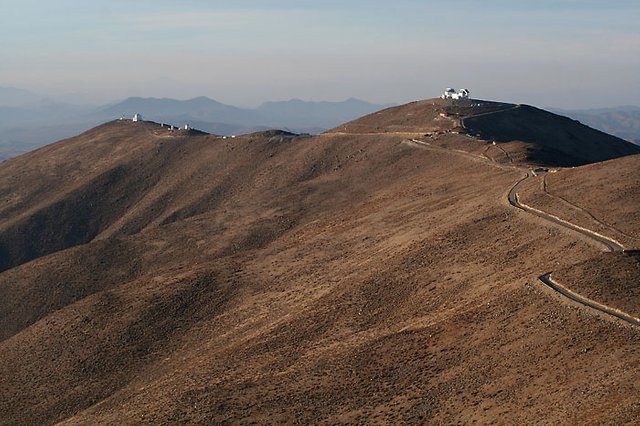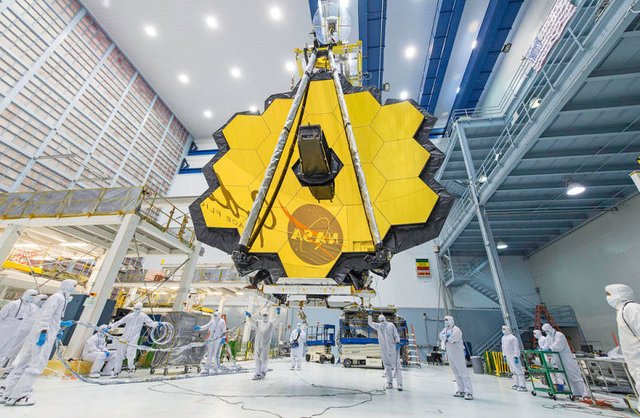THE TELESCOPE MAGALLANES - THE EYE THAT SPIES TO THE SPACE FROM THE EARTH
The Magellan Giant Telescope will be the first of a new class of extremely large telescopes that will be capable of producing images ten times sharper than those captured today by Hubble.
With this capability, the GMT's mission will be to discover Earth-like planets around nearby stars and the small disturbances that black holes cause in light from distant stars and galaxies. It will also reveal the weakest objects ever seen, including very distant and ancient galaxies, whose light has traveled to Earth since shortly after the Big Bang occurred, 13,800 million years ago.
"With science there are no limits to the possibilities that open up. What is opened is a door to knowledge, the route to new explorations and towards unknown possibilities begins ", President Michelle Bachelet
Telescopes are basically huge mirrors. In the case of the Magellan Giant Telescope, its main mirror combines seven segments of 17 tons and more than 8 meters in diameter each. Together they form an opening of almost 25 meters in diameter.
The process to create these mirrors lasts approximately four years: a year to mold and cool it and then more than three years to generate the surface and polish it meticulously, a process that will be carried out at the University of Arizona.
One of the mirrors is ready. Another three are being processed and additional ones will be produced, one per year until 2021, when the GMT will begin to operate, reaching its full operational capacity in ten more years.
The GMT will allow astronomers to characterize planets orbiting other stars, witness the early formation of galaxies and stars, and obtain evidence of dark matter and dark energy.
Giant Magellan Telescope
The Magellanic Giant Telescope (TGM or GMT in English) is a large-scale terrestrial telescope project planned for completion in 2020. It will consist of seven primary segments of 8.4 meters in diameter, with the resolution power of a primary mirror of 24.5 meters in diameter and the collection surface of 22 meters. It is expected to have more than 5-10 times the capacity of light collection of existing instruments. Four of the seven mirrors have already been produced and the top of the mountain is ready for construction. The chief astronomer in charge of the project is Mark M. Phillips.

image source :wikipedia
Location
The telescope will be located at the Las Campanas Observatory, which is also the site of the Magallanes Telescopes, about 50 kilometers south of Vallenar, Chile and 115 kilometers north-northeast of La Serena, Chile. The place is ideal to locate large astronomical observatories due to the dry climate of the surroundings of the Atacama Desert, without clouds or haze, nor atmospheric or light pollution. There are no population centers either. It is one of the best places in the world for astronomical observation. The exact point where the telescope will be built is 2,516 meters above sea level.

image source :wikipedia
Las Campanas Observatory
Characteristics
The telescope is unique, since it will have seven of the largest mirrors in the world as segments of the primary mirror, each measuring 8.4 meters in diameter. These mirrors will be organized with a mirror in the center and the other six arranged symmetrically around it. The challenge in this is that the six outer segments will be off-axis, and although identical with each other, they are not each radially symmetrical, which requires a modification of the usual polishing and testing procedures.
The mirrors are being built by the University of Arizona, specifically by the Steward Observatory Mirror Lab. The first mirror was created in a rotary kiln in October 2005, but the polishing was not completed until November 2012. A whole new and wide range of optical tests and laboratory infrastructure had to be developed to polish the mirrors, since the coefficient of difficulty is 10 times higher than for any previous large astronomical mirror. The second mirror began in January 2012, the third in August 2013 and the fourth in mid-2015. The fifth, sixth and seventh mirrors have not yet begun to be produced.
The intention is to build seven identical for off-axis mirrors, so that there is a spare available when one of them is in maintenance, (repainted) which takes up to a week, necessary and periodic process every one or two years. Although the primary mirror as a whole has a focal ratio (focal distance divided by diameter) of f / 0.71, the individual segments, being one third of diameter, have a focal ratio of f / 2.14. The focal ratio is in general f / 8 and the optical prescription is flat (without aberration of sphericity) of a Gregorian reflector telescope. The telescope will use adaptive optics.

image source :wikipedia
Comparison of the largest telescopes in the world.

THE STRUCTURE OF THE CUPLE.
With respect to the base, which is the telescope's support, the head of GMT in Chile added that "they are going to make some holes very carefully on the ground. If there is a fault, we must reinforce, and we do not want that when the excavations for these foundations are made, there are problems. You have to use explosives in a controlled manner, so that a part of the hill is not broken and no more fractures or faults are generated, "Roth said. These works will begin in the month of January and will be in charge of specialized companies, but they are national, because this is a job that is carried out in a very continuous way in mining. It should be noted that the work to flatten the hill began in 2012. And for this, more than 100 thousand cubic meters of material stone had to be removed. That work was done by a company linked to mining and that is national, and also participated in the flattening of the LSST (Large Synoptic Survey Telescope) in Cerro Pachón, about 80 kilometers from La Serena and very close to Vicuña. "These are companies with experience, with careful handling of explosives," Roth added. It should be noted that the origin of the area where Las Campanas is located and where the GMT will be located is volcanic. It is a very hard rock. AWESOME DIMENSIONS. The GMT will combine the light of seven mirrors of 8.4 meters each to create a telescope with an opening of 24.5 meters in diameter. With its unique design, the GMT will produce images in the infrared 10 times sharper than those of the Hubble Space Telescope. The strategic partners of the telescope, which expects to see its first light in 2023, will play an important role in the discoveries that will be made. And there are other data more decidores: the surface of the land where the GMT will be located measures 250 x 100 meters, that is to say about 25 thousand square meters. Easily, fit two professional soccer fields on this surface. The height of the GMT dome will be 63 meters, equivalent to approximately 22 stories high. And the collection area of the mirrors, measured as a total unit, corresponds to 368 square meters in general. In January, the foundations will begin to be installed, which will be the support for the future structure. This process could be extended for at least six months, which may vary depending on winter conditions. Then the construction of the dome will be carried out, previous call to the corresponding bids. That future structure will have gates that have to turn, which will contain cooling liquids, to which electrical energy must arrive, signals for the computers and for the control of the telescope. Actually, it is a complex structure, but one that arouses a greater interest in the field of science. "All this must move in a fine way, in such a way as to protect the telescope. 40% of the surface is opened, because it is important for the air to circulate and thus maintain an equal temperature with respect to the outside, "said Miguel Roth. The useful life of a telescope can reach 50 years. But there are some such as Monte Palomar, which opened in San Diego, California, in the late '40s, which continue to operate. "But if it has come down, it is because there is significant light pollution that has played havoc in this city," added the GMT representative in Chile.
THE SEARCH FOR LIFE.
Mark Phillips, former director of Las Campanas and one of the closest astronomers to the GMT project, who arrived in the country in 1977, points out that through emblematic initiatives such as the future telescope, one can continue to dream of finding new ways of life. "It is still possible for us to find life forms in other solar systems, apart from the Earth. The search for life is one of the number one priorities in astronomy, and there are many young astronomers dedicated to this. It is very interesting, "he said.
THE MIRRORS THAT LOOK AT.
The giant GMT mirrors have a very special way of making themselves. Said in simple words: in a very large oven, a mold is made on the outside, hexagonal refractories are placed and the floor is upholstered. Then the oven is closed, heated, covered with pieces of glass of 10x10 centimeters, which has similar characteristics to glass containers used for cooking. "This material expands and resumes its form. They are thousands of pieces of glass, then the oven is closed, and when the content is already getting a bit chewy, the oven starts spinning at five revolutions per minute. The glasses begin to melt and to occupy the spaces between the refractory. And he has the glass layer on him. That is the mirror. Then a slow process of gradual cooling of this structure begins, which can last up to three months, "Roth added. Subsequently, the refractories are removed and cleaned completely. Then the mirror is lifted, placed vertically and then sent to a machine where the back is polished, so that it can be worked on the front face. They are two years of very fine polishing, and only then meets the specifications. At present there is already a first finished mirror, and there is a second one in development. It is characterized by being very flexible, like a honeycomb.
PRIVILEGED HEAVENS.
Science is an indispensable part of the culture of a country. And in the opinion of people linked to astronomy, scientific advances have always had an impact on the development of nations. "And although progress is limited even from the perspective of the world of astronomy, there is growing interest," said Miguel Roth. Regarding the work carried out by the universities, the work started by the ULS is seen as important. "However, the University of La Serena for a long time could not be the leader despite having the race a department of astronomy incorporated, as it did not have the resources or support. But today they advance, "he stressed. Another very important aspect relates to the importance of astrotourism, which can be a gateway to knowledge and science. Even, at some time the Tololo Observatory encouraged the visit to its dependencies, seeing itself surpassed. This is how Mamalluca emerges as a tourist observatory, where there is the possibility of observing, unlike the observatories of astronomical professionals. Thus, the sublime art of looking is achieved.
References
- José Terán U .; Daniel H. Neff; Matt Johns (May 29, 2006). Conceptual design study of the GMT enclosure. SPIE 6267: Symposium on Astronomical Telescopes and Instrumentation. Orlando, Florida: SPIE. p. 2. Consulted on March 31, 2008.
- Joanna Thomas-Osip (March 20, 2007), "The Seeing and Turbulence Profile at The Observatory Bells: GMT Site Testing Progress Report," Symposium on Seeing, Kona, Hawaii: AAS, p. 3, consulted on March 31, 2008
- Kyle Mittan - Steward Observatory casts second mirror for Giant Magellan Telescope (2012)
- Harvard Magazine - Giant Magellan Milestone (2013)
Ryman, Anne (December 15, 2015). «UA gets $ 20 million grant towards giant telescope». The Arizona Republic. Retrieved on June 4, 2015.